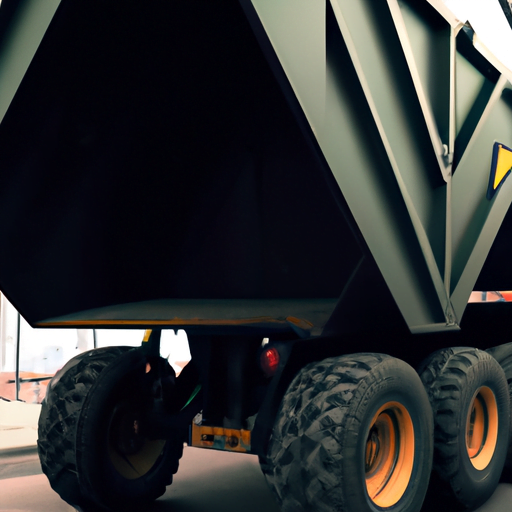-
Table of Contents
Introduction

Sunday Reads: The History of Dump Trailers provides an in-depth look into the evolution and technological advancement of dump trailers. This comprehensive account delves into their origin, historical significance, modifications over time, functionality improvements, and their current state within modern industrial sectors. It is a must-read for those interested in construction machinery history or mechanical engineering marvels.
Sunday Reads: Tracing the Evolution of Dump Trailers Through History
Settle in for your Sunday reads and let us embark on a fascinating journey through the evolution of dump trailers. In this narrative, we’ll discover that these ubiquitous fixtures of construction sites and large-scale projects have a rich history stitched into the fabric of industrialization itself!
The origins of dump trucks can be traced back to late 19th century Europe – specifically England. This was during the zenith of the Industrial Revolution, where innovative minds sought practical solutions to newfound challenges in mining and construction. Conventional horse-drawn wagons were painstakingly slow for transporting heavy materials across vast worksites.
Therefore, there came about what is considered by many as an ancestor to modern-day dump trailers: The revolutionary steam-powered tipper wagons with rear-unloading capability designed by brothers John Thomas Crompton and Joseph Frederick Crompton! These vehicles significantly accelerated work tempo at quarries and mines.
As time marched forward into the early 20th century, technology continued its relentless march too. Cue Robert W. LeTourneau from California – enterprising inventor extraordinaire who patented his first fully mechanized towed trailer dumper in 1922! By incorporating hydraulics into his design conceptually similar to those used today, he revolutionised efficiency; tasks that once took days could now be finished within hours.
This marked a transformative period for dump trailers as they gradually replaced man or animal powered mechanisms making them superior choices for larger operations such as road building or excavations. Also worth noting from this era is Wood Hoist Co.’s contribution – their automatic end dumps were lauded as state-of-the-art additions to truck bodies which made unloading quicker than ever before.
From mid-century onwards things really started picking up speed thanks largely due to development leaps made post World War II when demand soared new roads housing developments throughout U.S.A., Europe Asia alike required massive amounts transportation earth minerals everything else between — ‘Dumping’ became an indispensable part construction industry’s arsenal.
In the late 20th century, with the advent of computer-assisted design and manufacturing technologies, dump trailers advanced at a rapid pace. Designs became more refined for efficiency and safety, whilst materials transitioned from primarily steel to also include lightweight yet durable aluminum. Innovation didn’t stop here though; we saw enhancements in automation along with improvements axle configurations that allowed carrying greater loads without sacrificing maneuverability or violating weight restrictions imposed by authorities.
As we travel to present day reality from a past steeped in innovation persistence it is exciting think about where modern dump trailer technology might lead us. With trends like electric heavy machinery emerging global emphasis on reducing carbon footprint there’s no doubt that manufacturers will continue pushing envelope future designs. Still essence remains same: efficient reliable transportation hefty goods one place another testament enduring legacy these machines bring picture industrial evolution!
That concludes our historical journey through the world of dump trailers—a tale of ingenuity and ceaseless improvement driven by steadfast determination to solve logistical challenges efficiently effectively as possible! Here’s hoping next time you spot mammoth machine churning dust proudly its way across construction site mining quarry you’ll have newfound appreciation magnificent piece engineering history carries within every nut bolt.
The Fascinating History of Dump Trailers – Our Sunday Reads Spotlight.
In today’s Sunday Reads spotlight, we delve into the fascinating history of dump trailers. Though they are everyday sights at construction sites and on highways, most people give scant thought to these essential vehicles’ origins— but their story is a riveting one indeed.
The history of dump trailers goes hand-in-hand with the evolution of roads and transportation systems around the world. The first patented dump trailer appeared in 1844 when Heinrich Bothmann, a German engineer, crafted an innovative solution for moving heavy loads easily —a cart that could tilt backwards to unload its contents automatically. However, this contraption was horse-drawn since motorization was still decades away.
As industries expanded during the Industrial Revolution in the late 1800s and early 1900s, there arose an increased need for efficient ways to transport materials like coal, gravel or debris from place to place. It wasn’t until Robert W. Woodruff witnessed laborers struggling with traditional wagons that he recognized an opportunity waiting to be seized.
Woodruff’s version of a horse-drawn dumping mechanism revolutionized cargo transportation forever by replacing human power with animal stamina; significantly reducing manpower while increasing productivity on work sites—a veritable game-changer!
Fast forward thirty years later – enterprising brothers Cass and James Johnson introduced modern hydraulic technology redesigning Pearman dumper’s original manual pulley system into automatic hydraulics thus further improving efficiency dramatically.
Fueled by innovation within just two short decades after World War I ended; multi-axle semi-trailer trucks were born out of necessity as America underwent massive infrastructural development under President Roosevelt’s New Deal during Great Depression era creating unprecedented demand for hauling services nationwide propelling industry forwards exponentially making concept pioneered earlier century core part nation building process onwards towards middle twentieth century till now present day where advent computer technology has bred new generation digital age intelligent automated self-driving remote controlled technological marvels fulfilling ever growing societal needs constantly evolving driving force global economy.
On the surface, dump trailers might seem like simple tools that carry and unload different materials. But the reality paints a picture of an innovative machine, central to our global infrastructure. Its history is marked by human ingenuity and technological advancement- from horse-drawn mechanisms to multi-axle mega machines equipped with hydraulic systems.
The trajectory of dump trailer development tells us about society’s progress over time. What began as a straightforward solution for moving bigger loads has evolved into sophisticated equipment powered by advanced technologies— all aiming towards making work easier and more efficient for humanity. And who knows what future innovations lie ahead? Perhaps fully autonomous vehicles or greener energy sources?
So next time you encounter one of these magnificent vehicles on your commute, take a moment to appreciate its rich history and contribution it makes in shaping our world every day! Ultimately, they are not just colossal beasts carrying mounds of earth; they are symbols of human progress across generations right under your nose!
That wraps up this week’s Sunday Reads spotlight on the captivating history of dump trailers—a subject often overlooked but undeniably significant. Stay tuned for more exciting tales from less-explored corners of knowledge next week!
Sunday Reads: Unearthing The Historical Development and Transformation of Dump Trailers.
Dump trailers, often seen at construction sites and ubiquitous in the transportation industry, have an intriguing history that is mostly forgotten. As we embark on this Sunday read, we aim to shine a light on their historical development and transformation over time.
Our journey begins in the initial era of motorized vehicles when horses were still a prevalent means of transport. The early 1900s saw horse-drawn dump wagons carrying goods from farms to markets as well as facilitating city waste management systems. Mass production became possible only after the advent of reliable internal combustion engines around World War I. And so emerged our first rudimentary motorized dump trucks – a tremendous leap forward for transporting heavy materials cheaply and efficiently.
However, it wasn’t until Robert Wood Hooper invented the hydraulic dumping mechanism around 1920 that these versatile machines truly revolutionized industries ranging from mining to construction to agriculture—and even war efforts during World War II! By using hydraulics—fluid forces under pressure—to lift heavy loads easily and safely, Hooper’s invention cleared obstacles out of any project’s path by providing a quick way of unloading cargo without manual lifting or shovel work.
But don’t assume these innovations came easy; like anything worthwhile they had their share of trials too! Early versions suffered frequent breakdowns due to poor quality parts and lackluster design choices which made them unpredictable at best and downright dangerous at worst!
Nevertheless, manufacturers persisted with iterative improvements throughout the mid-twentieth century resulting in better reliability, safety features like automatic locking tailgates for preventing accidental discharge while driving , more robust designs capable of handling heavier loads ,and increased automation lowering labor needs remarkably.
Now fast-forwarding into modern times what was once just a simple machine lacking engine power or mobility has been transformed into something grander – Heavy Duty Dump Trailers armed with advanced technology are completely autonomous now!. GPS tracking capabilities monitor route efficiency , AI technologies predict maintenance needs reducing costly downtime incidents and materials like high-strength low-alloy steel or aluminum alloys are used to increase durability while slashing empty weight improving fuel efficiency . The latest models often come with multiple axles, allowing them to comply with road regulations for maximum weight capacities depending on each country’s specific laws.
However even all this innovation hasn’t curtailed the spirit of continued improvement! Companies worldwide are looking towards sustainability trends, not only as a means of curtailing our carbon footprint but also in a bid to save costs further! Electric dump trailers powered by renewable energy sources like solar panels or wind power promise an exciting future devoid of polluting emissions.
The story we’ve traced isn’t just about how far we’ve come in terms of technological advancement – it’s a testament to human endeavor and creativity, which has proved unbounded through generations. From horse-drawn wagons to state-of-the-art autonomous vehicles: our ingenuity keeps finding ways around difficulties resulting in ever more efficient methods aiding industries across board
And that concludes our Sunday read folks! As you head into your week ahead remember – there’s always something extraordinary hiding behind seemingly ordinary objects- should one choose to look closer!. Whether it’s the history etched on every rivet and bolt ,the silent hum of technology purring under metallic skin or simply marveling at how simple machines have transformed livelihoods over centuries—perhaps next time you see a dump trailer passing by; you’ll spare it another glance acknowledging its rich heritage!
Q&A
1. Question: What is a dump trailer?
Answer: A dump trailer is a semi-enclosed vehicle that is mainly used to transport materials such as sand, gravel, and demolition waste for construction.
2. Question: When was the dump trailer invented?
Answer: The first motorized dump trucks appeared in the United States in the early 20th century.
3. Question: How have dump trailers evolved throughout history?
Answer: Initially, they were simple open body trailers which could be pulled by horses but with time they became motorized and more sophisticatedly designed with hydraulic systems for efficient loading and unloading of materials.
Conclusion
The history of dump trailers is a fascinating journey that reflects human innovation and technological advancement in the field of transportation and construction. The development of dump trailers has played an integral role in enhancing efficiency and productivity in various industries, especially the construction sector. Over time, these essential vehicles have undergone significant transformations to improve their functionality.


I do trust all the ideas you’ve presented in your post. They are really convincing and will definitely work. Nonetheless, the posts are too short for newbies. May just you please lengthen them a bit from next time? Thank you for the post.
Hi my family member! I want to say that this post is awesome, nice written and come with approximately all significant infos. I would like to peer extra posts like this.